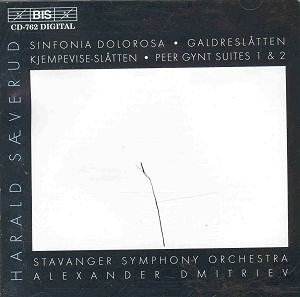The
Peer Gynt music is a conflation of the thirteen
movements of the two suites Sæverud drew from the incidental
music he wrote in 1948. At that time there was a feeling that
Grieg's music with its romantic overlay was distorting the subtle
psychological dimensions of the play. At first Sæverud was
reluctant to accept the commission but the music came to him and
flowed quickly. It is replete with the caustic, with skirling
dissent. The style is somewhere between Prokofiev at his most
lyrical and Stravinsky's Pulcinella phase. In the Blandet
selskap (tr.5) various national anthems and songs are treated
to a brutal and rattlingly sardonic outing. The Gravsalme
is as awesomely sombre as the name suggests - the single most
impressive movement being a soulful cortège.
The
single movement Sinfonia Dolorosa is dedicated to
a close friend, a member of the Resistance who was executed by
the Nazis. It has the gravitas of the Gravsalme from the
Gynt music. It is not acerbic and in fact is about as tough
as the Salme - i.e. not very. Its originality can be undeniably
felt in the thunderous gallop at 10.35 which then rises to a Leningrad-like
paean of what I can only describe as angry praise - Old Testament
exultation in blood-letting rather than enlightened New Testament
values. It is the second of his three so-called war symphonies.
The
Galdreslåtten and Kjempevise-slåtten
are two short pieces of overture-like dimensions. They
are however more in the nature of symphonic studies than jeux
d'esprits. The Galdres work has elements of Nielsen's
later jerkily explosive writing. The Kjempevise-slåtten
came to be regarded as a symbol of the Norwegian Resistance
movement. It is dedicated 'to the fighters both great and small
on the home front.' The work combines Sibelian cantabile
(listen to the theme at 03.34), drama (Pohjola's Daughter)
and Polovtsi character with occasional facets of Hovhaness. More
fumingly Old Testament angry triumphalism also surfaces towards
the end of the piece.
Rob
Barnett
